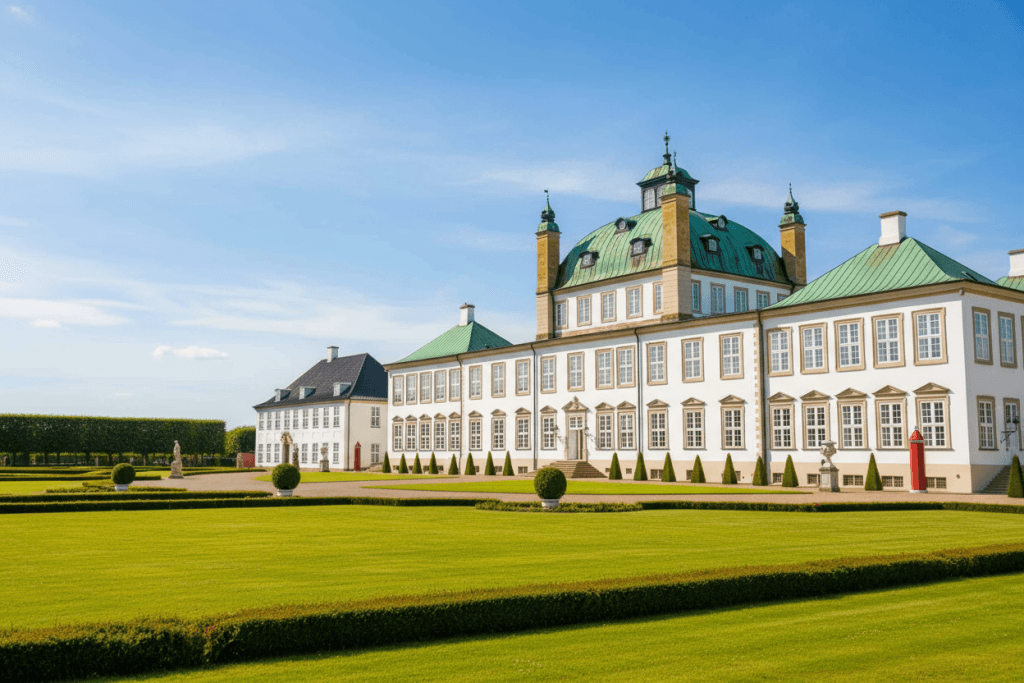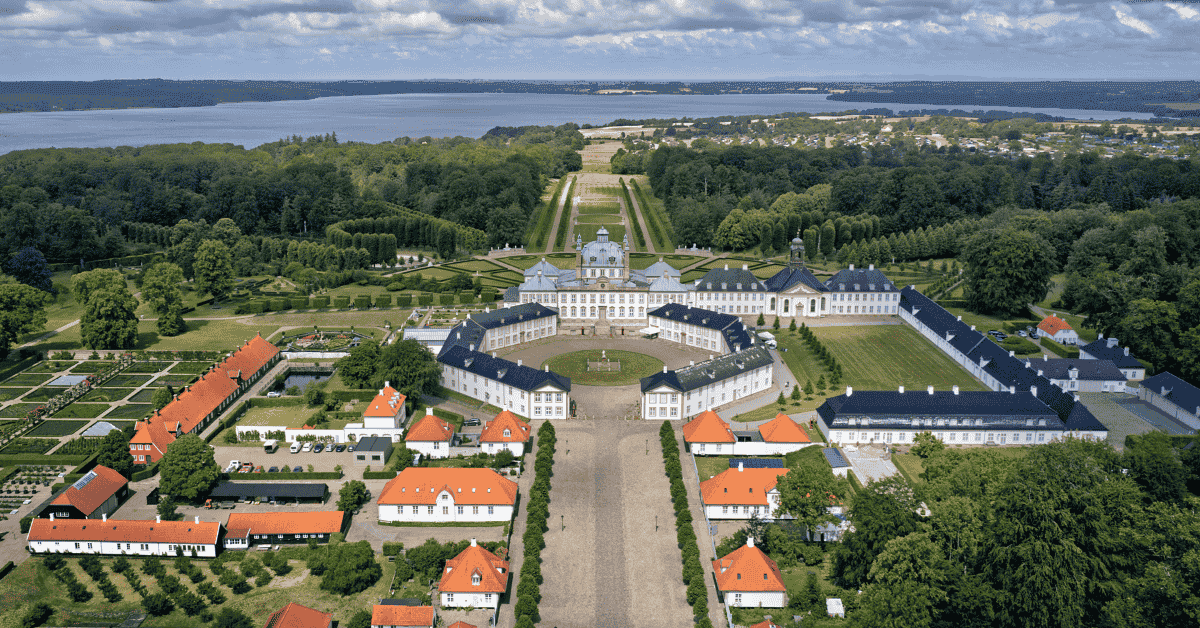Fredensborg Palace (Danish: Fredensborg Slot) is located in northern New Zealand, just 40 kilometers north of Copenhagen. As such, it remains one of Denmark’s most cherished and admired royal residences.
This enchanting palace is not only a marvel of architectural excellence but also an emblem of the Danish monarchy’s storied history. Fredensborg Palace serves as the spring and autumn residence for the Danish Royal Family, symbolizing Denmark’s rich history.
- Fredensborg Palace’s Location and Significance: It is located 40 km north of Copenhagen in northern Zealand. It serves as a cherished royal residence symbolizing Denmark’s rich history and monarchy.
- Role in Royal Celebrations and Diplomacy: The palace hosts royal weddings, anniversaries, and state banquets. The rayal family reside at certain times of the year.
- Historical and Cultural Significance: It was named ‘Fredensborg’ to symbolize peace (literal translation is the peace castle). The palace has been a site of tranquility and diplomacy and has preserved its role as a royal retreat and a symbol of Denmark’s heritage.
- Architectural Excellence of Fredensborg Palace: It was built between 1719 and 1722 in Baroque style. It features an octagonal layout with a grand dome, often called the ‘Versailles of the North’ for its elegance.
An Architectural Marvel
Constructed between 1719 and 1722, Fredensborg Palace is a testament to the elegant sophistication of Baroque architecture. King Frederick IV commissioned the palace as a peaceful retreat from the busy life of the capital. Italian architect Nicolai Eigtved shaped the palace’s design, blending Italian and French styles to create timeless elegance. The palace is renowned for its distinctive octagonal layout, crowned by a grand dome, which is a striking feature of its design. With its meticulously manicured gardens and stately appearances, Fredensborg is often referred to as the “Versailles of the North,” drawing parallels to the opulence of France’s Palace of Versailles.
A Centerpiece of Royal Celebrations
Fredensborg Palace has been at the heart of many royal celebrations and events, enhancing its significance within Denmark’s cultural tapestry. It is traditionally the setting for royal weddings and anniversaries. Most notably, Crown Prince Frederick and Crown Princess Mary celebrated their marriage at Fredensborg Palace in 2004, a joyous event that captured both national and international attention. The palace also plays host to the annual state banquet attended by foreign ambassadors, an event that underscores Denmark’s diplomatic engagements.

Symbolizing Peace and Diplomacy
The name “Fredensborg” itself signifies “the castle of peace.” The palace was christened as such following the conclusion of the Great Northern War, marking a period of peace and prosperity for Denmark. Over the years, it has tirelessly upheld its role as a venue for diplomatic interaction, welcoming countless dignitaries and heads of state. This cultural beacon represents Denmark’s enduring commitment to peace and dialogue.
A Royal Residence Steeped in Tradition
The importance of Fredensborg Palace is further underscored by its role as a royal residence serving both ceremonial and private purposes. It is here that members of the Danish Royal Family retreat to during the spring and autumn months, enjoying the tranquility of its extensive grounds. The sprawling estate includes one of Denmark’s largest and most stunning formal gardens, which comprises an expansive Baroque-style garden, a reflection pond, and a renowned sculpture park. The gardens extend over 120 acres, featuring more than 70 sculptures, primarily neoclassical pieces by J.G. Mayer, which vividly illustrate the palace’s fusion of art and nature.
Inspiration Through Generations
The palace complex includes an array of historically significant outbuildings and features, such as the Chapel and the Orangery. The Fredensborg Palace Chapel, which has remained unchanged since its inauguration in 1726, continues to serve as a splendid example of ecclesiastical architecture from the period. The Orangery, initially designed for cultivating orange trees, now serves as part of the royal gardens where flora and fauna can thrive within its vast glass-paned structures.
The significance of Fredensborg Palace resonates through centuries as a cultural and architectural masterpiece. As a residence imbued with both historical resonance and current relevance, it embodies the essence of Danish royal tradition and the country’s rich heritage. Whether serving as a backdrop for pivotal historical events or acting as a peaceful retreat for the royal family, Fredensborg Palace plays an indispensable role in carving the narrative of Denmark’s monarchy, firmly ensconced as a treasured landmark within the tapestry of Denmark’s identity.
Visiting Fredensborg Palace: A Timeless Experience
Fredensborg Palace, with its breathtaking architecture and serene gardens, is a must-visit destination for history enthusiasts and admirers of royal culture. Although it serves as an active residence for the Danish Royal Family, there are ample opportunities for tourists to explore this magnificent site and its surroundings.
Exploring the Charm of Fredensborg Palace
Visitors eager to delve into the royal experience can enjoy guided tours of the palace’s resplendent grounds during the summer months. Typically, these tours are offered from July to August when the royal family is away on vacation, and sections of the palace are opened to the public. These tours offer an insightful glimpse into the history and daily life of the Danish monarchy, covering key areas such as the Chapel and parts of the main building. The tour often highlights the intricate craftsmanship and rich artworks that adorn the palace’s interiors. During peak tourist season, each tour lasts approximately one hour, guiding visitors through the storied halls while providing engaging narratives of the palace’s past and present.
A Visit to the Gardens
While access to the palace’s interior is limited to specific times of the year, the exquisite Fredensborg Palace Gardens stand as a year-round attraction. Spanning over 120 acres, these gardens, with their meticulously designed Baroque and English landscaping styles, remain open to visitors daily from 9 am to sunset. A leisurely stroll through the vibrant display of flowers, manicured hedges, and the famous Valley of the Norsemen sculpture garden will transport guests to an era of elegance and tranquility. Noteworthy events, such as the annual garden concert, add to the allure of the gardens, allowing visitors to enjoy art and culture within a royal setting.
Tip for Garden Enthusiasts: Consider visiting in spring or autumn to witness the gardens at their most picturesque. The riot of colors in spring or the golden hues of autumn foliage offers an unparalleled visual treat.
Practical Tips for Visitors
Planning a visit to Fredensborg Palace requires some key insights to maximize enjoyment and convenience. Here are some practical tips for those planning their trip:
Getting There: Easily accessible by both car and public transport, Fredensborg Palace is about a 40-minute drive from Copenhagen. Travelers using public transport take a train to Hillerød, then a bus to Fredensborg; the total trip is one scenic hour.
Tickets and Tours: Tickets for the summer palace tours can be purchased online or at the entrance. It’s advisable to book in advance, as tour slots tend to fill up quickly during peak tourism months.
What to Bring: Comfortable walking shoes are a must, given the expansive grounds and gravel paths. Visitors during cooler months should wear warm clothing, as the gardens involve extended time outdoors.
Photography: While visitors may photograph the gardens, guides restrict photography in certain areas inside Fredensborg Palace during tours. Be sure to check onsite regulations to ensure compliance and courtesy towards the site’s heritage.
A Full-Day Royal Experience
To make the most of your visit, consider a full-day royal itinerary that includes Fredensborg Palace, the historical city of Hillerød, and the awe-inspiring Frederiksborg Castle located nearby. This royal trio offers a comprehensive exploration of Danish history, culture, and architectural splendor.
Plan your visit wisely to enjoy Fredensborg Palace’s regal aura, historical wonder, and surrounding natural beauty all day. Whether exploring tranquil gardens or grand halls, you’ll find Fredensborg Palace adds unforgettable charm to your Denmark journey.
Conclusion: Fredensborg Palace – A Regal Experience
In the serene environs of northern Zealand, Fredensborg Palace stands as a resplendent symbol of Denmark’s royal pride and historical continuity. This iconic royal residence showcases Baroque elegance and heritage, welcoming visitors to explore ceremonies, design, and history. Fredensborg Palace offers guided tours and serene gardens, giving visitors a deeper understanding of Denmark’s rich royal legacy.
Summary
– Historical Significance: Originally built from 1719 to 1722, Fredensborg Palace now serves as the Royal Family’s spring and autumn residence.
– Architectural Marvel: The palace showcases Baroque architecture with its octagonal layout and majestic dome. In comparison, many liken it to the grandeur of Versailles.
– Cultural Centerpiece: Renowned for hosting royal weddings, anniversaries, and state banquets, it stands as a monument of diplomacy and celebration.
– Visitor Experience: Seasonal tours reveal royal life. Meanwhile, the gardens stay open year-round, offering a peaceful retreat into nature.
– Travel Tips: Easily accessible from Copenhagen via public transport or car. Visitors are encouraged to visit the gardens in the spring or autumn for optimal beauty.
Frequently Asked Questions about Fredensborg Palace
1. When is Fredensborg Palace open to visitors?
Fredensborg Palace itself opens to the public for guided tours during the summer months of July and August. However, the gardens are accessible every day of the year from 9 am to sunset.
2. Can visitors see all areas of the palace during the tours?
Access inside the palace is limited, with guided tours covering select areas like the Chapel and parts of the main building. The tours provide historical and cultural insights into the palace’s significance.
3. How can I get to Fredensborg Palace from Copenhagen?
Fredensborg Palace is reachable by a 40-minute car drive from Copenhagen. Alternatively, visitors can take a train to Hillerød, then a bus to the palace, total travel time is one hour.
4. Are photography and videography allowed inside the palace?
Photography is usually allowed in the gardens, but there may be restrictions within the palace during guided tours. It’s best to check on-site guidelines to adhere to the regulations.
5. Is there an admission fee for visiting the gardens?
Currently, entering the gardens is free, but a fee is required to join guided tours inside the palace. Tickets for the tours can be purchased online or at the palace at specified times of the year.
6. Are there any dining facilities available on site?
Although Fredensborg Palace lacks dining, visitors can easily enjoy meals at nearby cafes and restaurants in Fredensborg town.
7. What are some recommended nearby attractions to visit?
After exploring Fredensborg Palace, visit Frederiksborg Castle in Hillerød for more of Denmark’s royal history and culture.
8. Is Fredensborg Palace accessible to people with disabilities?
While accessibility has improved at Fredensborg Palace, some areas remain challenging due to the site’s historical design.
With its rich history and beauty, Fredensborg Palace still captivates visitors and offers insight into Denmark’s royal heritage. Whether admiring architecture or strolling through gardens, you’ll enjoy an unforgettable, enriching experience at this majestic palace. through







